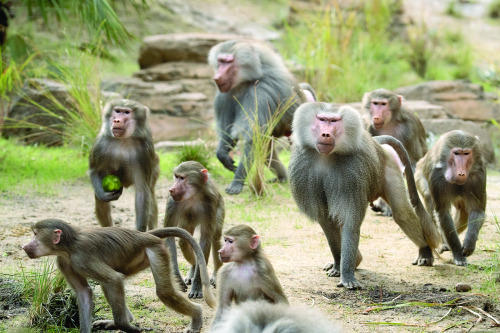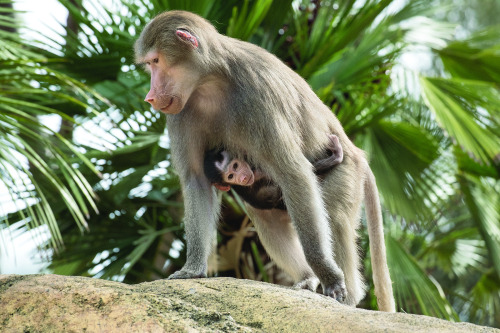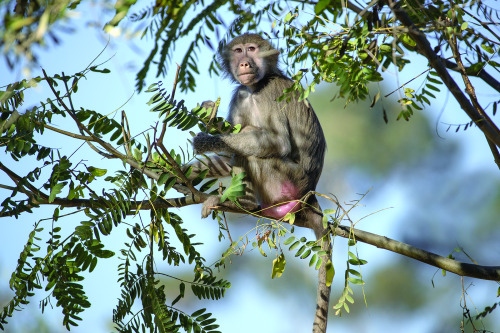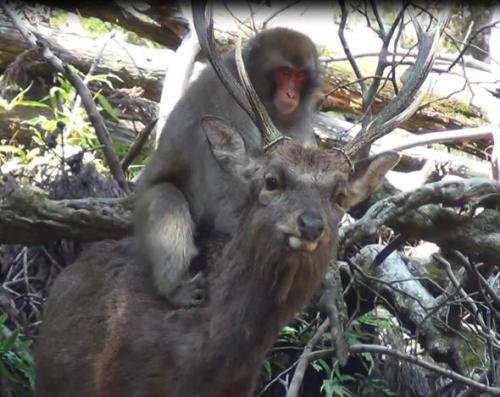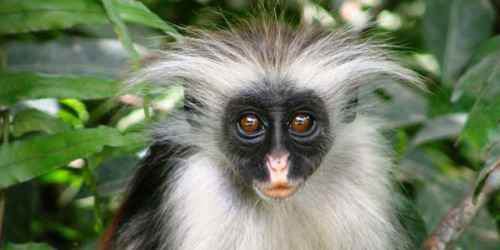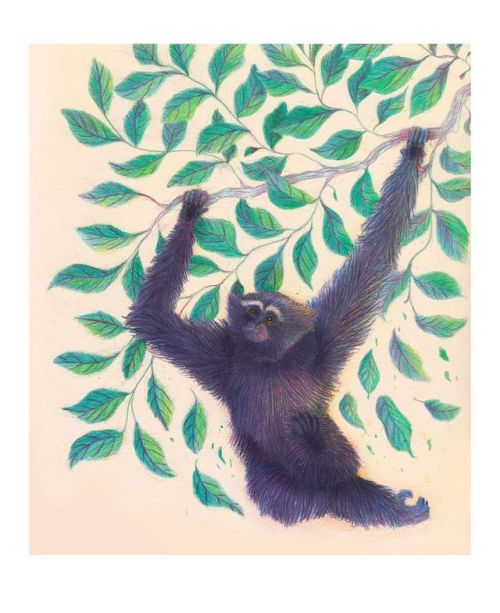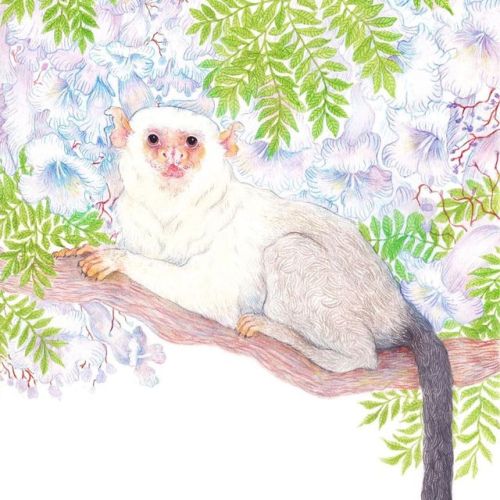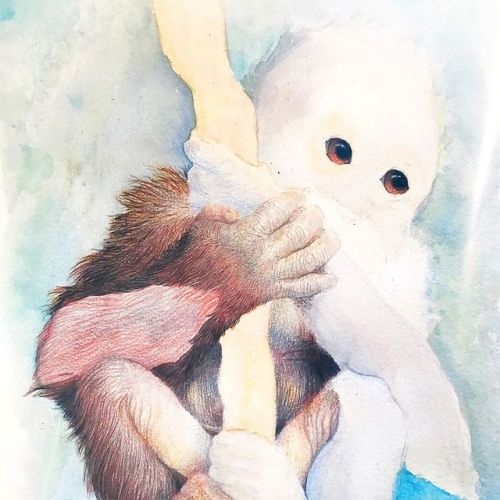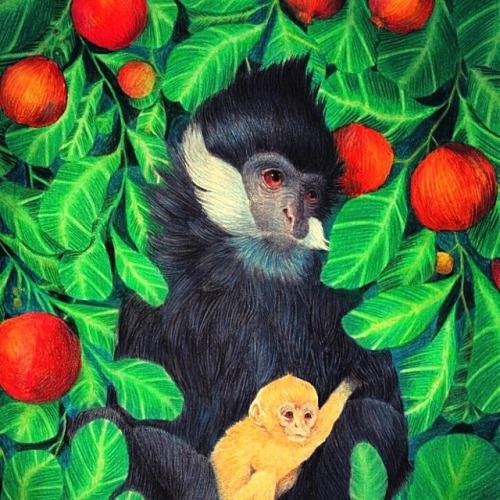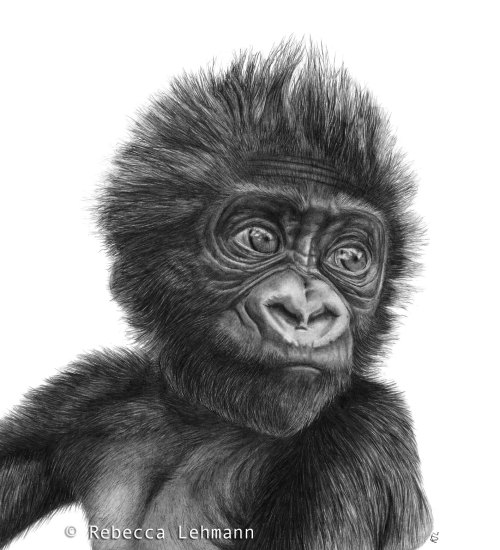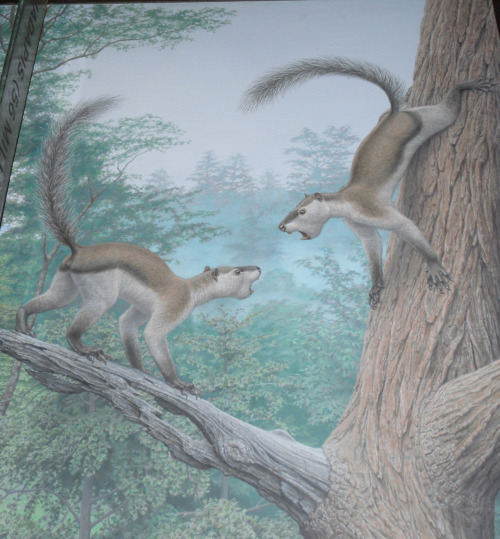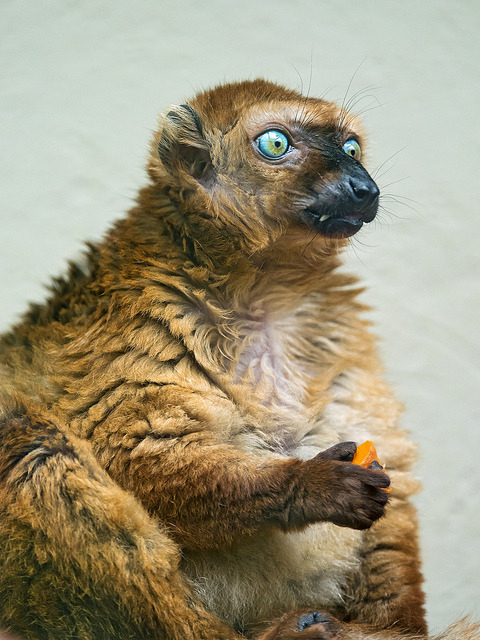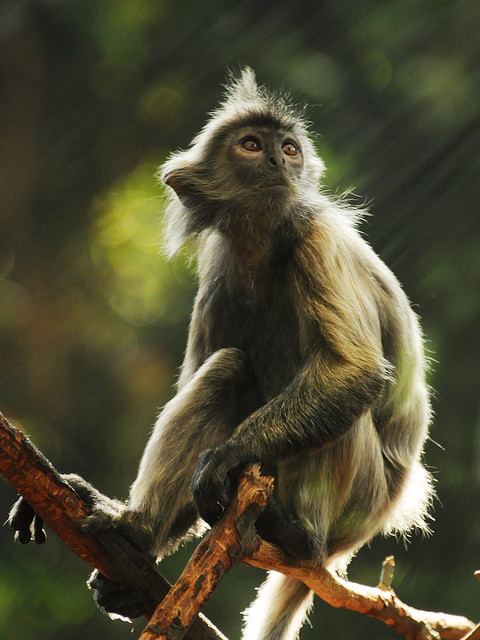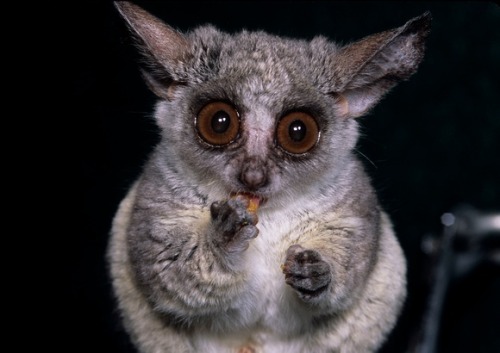#primate
When our boisterous baboon band charges into their expansive, naturalistic habitat, the daily spectacle stops Zoo visitors in their tracks. http://bit.ly/HBaboon318
Post link
Female Monkeys Seen Having ‘Sexual Interactions’ With Deer
There’s some unusual monkey business happening on an island in Japan.
On December 11, scientists at the University of Lethbridge in Canada published a paper revealing what appear to be sex acts between young female Japanese macaques and sika deer. The wild monkeys were observed mounting the deer in Minoo, central Japan.
Similar monkey-deer interactions on Yakushima Island were reported in January 2017. Locals in Minoo most likely have been observing these behaviors since at least 2014, says study co-author Noëlle Gunst. But while the previous research is based on anecdotal evidence, the current work focuses on the numbers.
According to the team, which also consists of researchers Paul VaseyandJean-Baptiste Leca, this paper is the first quantitative study of sexual interactions between a non-human primate and a non-primate species.
“These findings support the view that monkey-deer mounting behavior is a sexual practice during which the adolescent female monkeys probably derive sexual gratification,” Gunst writes in an email.
DEER MATES
Wild Japanese macaques have long been known to ride sika deer. The monkeys will sometimes groom their four-legged mounts, while the deer get to eat any fruits the macaques drop and occasionally make meals of the monkeys’ feces. (See a weasel flying on a woodpecker, a seal surfing on a whale, and other animals riding animals.)
The latest study looked at mating season interactions from videos of the behavior and hormone testing from fecal samples. The researchers compared 258 monkey-deer interactions to homosexual contact observed between female macaques in the past.
Based on instances of mounting, thrusting, and vocalizations, the team concludes that these relations were, in fact, sexual. In some cases, the macaques also bit the deer or pulled on their antlers. (If you’re wondering, there is video.)
The researchers observed 14 different monkey-deer pairings. In five cases, female monkeys mounted the same quadruped partner three or more times in a 10-minute period and made the same calls heard when monkeys mate with each other. In other cases, female macaques interrupted sex acts started between other monkeys and deer. Gunst says the interactions occurred about once every day and lasted from a few minutes to about two hours.
For the most part, the deer didn’t seem to care. Some of the deer shook the monkeys off their backs, but others stood passively while the monkeys thrusted. In some cases, the deer just kept on eating.
MONKEY MOTIVATION
Interspecies sex is not unheard of; 10 percent of animal species are known to hybridize. But this practice is more common in animals that are anatomically similar. Since monkeys and deer are so physically different, it’s highly unlikely the macaques confused the deer with a potential primate mate.
“Heterospecific sexual interaction between non-closely related species is very rare to observe,” Cédric Sueur, who published the previous study on monkey-deer relations, told National Geographic in January.
Post link







The mouse lemur is the smallest primate in the world, with a combined head, body, and tail length of less than 30cm (11.8"). It is native to Madagascar and is nocturnal. Mouse lemurs are considered cryptic species—with very little morphological differences between the various species, but with high genetic diversity.
Lemurs and mouse lemurs were announced by the IUCN as the most endangered of all vertebrates. There were 2 known mouse lemur species in 1992; by 2016, there were 24.
Hi, it’s The Zanzibar red colobus (Procolobus kirkii)also known as Kirk’s red colobus. It was called after “ Sir John Kirk, the British Resident of Zanzibar who first brought it to the attention of zoological science”, but it’s funny, Kirk has his own primate.
Post link
A leaf monkey
.
.
.
.
.
.
.
.
.
.
.
.
.
.
.
#wildanimals #nature #illustration #art #animal #etsyartist #estyart #wildlifeart #wildlife #wildlifeartist #natureartist #drawing #natureart #threatenedwildife #conservation #animalartwork #animals #pencil #primate (at Oxford, Oxfordshire)
https://www.instagram.com/p/By5ZjljgU_s/?igshid=1xgr3g0y1ss3p
Post link
A male western hoolock gibbon for @sarah_be12
This species is endangered and can be found in India and Bangladesh
.
.
.
.
.
.
.
.
.
.
.
.
#wildanimals #nature #illustration #art #jenmuir #platypusradio #wildlifeart #wildlifeartist #natureartist #animal #wildlife #watercolor #drawing #animals #polychromos #watercolour #painting #animalartwork #gibbon #conservation #threatenedwildife #primate #commission (at Oxford, Oxfordshire)
https://www.instagram.com/p/Bxsdnj6FAzS/?igshid=2n8vrir4tv79
Post link
A silvery marmoset
.
.
.
.
.
.
.
.
#platypusradio #jenmuir #art #nature #etsyartist #estyart #wildlifeart #wildlifeartist #natureartist #animal #wildlife #illustration #pencil #wildanimals #watercolor #drawing #artist #animals #watercolour #painting #conservation #animalartwork #primate #marmoset (at Cowley, Oxfordshire)
https://www.instagram.com/platypusradio/p/BxKuyj_lyIv/?igshid=1ay6tpqs4hwnj
Post link
The finished piece✨
All three species of orangutan are critically endangered, threatened by habitat loss and the illegal pet trade. You can help these species by helping out groups such as @orangutan_foundation, @orangutanfoundationintl, and @theorangutan project
.
.
.
.
.
.
.
.
.
.
.
#wildanimals #nature #watercolor #illustration #polychromos #art #animal #etsyartist #estyart #primate #watercolour #wildlifeart #wildlife #wildlifeartist #natureartist #jenmuir #platypusradio #conservation #orangutan #animals #animalartwork #threatenedwildife #painting (at Cowley, Oxfordshire)
https://www.instagram.com/platypusradio/p/BwpYeK8FT_k/?utm_source=ig_tumblr_share&igshid=juerfsj90qb9
Post link
A golden handed tamarin, found in Brazil, Guyana, French Guiana, and Suriname
.
.
.
.
.
.
.
.
.
.
#wildanimals #nature #art #animal #oxford #etsyartist #estyart #wildlifeart #wildlife #wildlifeartist #natureartist #jenmuir #platypusradio #animals #animalartwork #watercolor #illustration #polychromos #tamarin #watercolour #primate #conservation (at Oxford, Oxfordshire)
https://www.instagram.com/platypusradio/p/BwkI71slQB5/?utm_source=ig_tumblr_share&igshid=dn7jotyju44s
Post link
Work in progress
.
.
.
.
.
.
.
#wildanimals #nature #watercolor #illustration #pencil #polychromos #art #animal #etsyartist #estyart #primate #wildlifeart #wildlife #wildlifeartist #orangutan #natureartist #jenmuir #platypusradio #threatenedwildife #conservation #animalartwork #animals #workinprogress #WIP #watercolour (at Oxford, Oxfordshire)
https://www.instagram.com/platypusradio/p/BvwpSV3htn3/?utm_source=ig_tumblr_share&igshid=1goslc4v0eer5
Post link
Happy mother’s day✨
Francois’ langurs are an endangered species of primate found in China and Vietnam.
For every purchase of a print, 20% of the profits will be donated to Project Anoulak (@conservationlaos ), who work in Laos, researching and spreading awareness of wildlife, and creating sustainable livelihoods for the local community
.
.
.
.
.
.
#wildanimals #nature #art #oxford #etsyartist #estyart #wildlifeart #wildlife #jenmuir #platypusradio #animals #illustration #pencil #animal #wildlifeartist #natureartist #conservation #watercolour #polychromos #threatenedwildife #primate #animalartwork #mothersday
https://www.instagram.com/platypusradio/p/BvrSCpHlx7P/?utm_source=ig_tumblr_share&igshid=vyw6qp0vwf9b
Post link
Black and white Lemur, taken at the Erie Zoo.
I’m really proud of this one!
As you should be!
Post link
Plesiadapis
Mounted specimen on display at the American Museum of Natural History, NYC
Reconstruction by Jay Matternes
When: Late Paleocene to Early Eocene (~ 61 - 55 millon years ago)
Where: North America and Europe
What:Plesiadapis is a small tree-dwelling mammal that was fairly comment in the late Paleocene of North America and Europe. This ancient mammalian taxon was about the size of a house cat, and though it may look very reminiscent of a squirrel it is a member of the primate family, as part of the larger group Plesiadapiformes. The latest research has shown that Plesiadapis was actually atypical for its namesake clade; this genus tended to be much larger than the average plesiadapiform and was not as well adapted for climbing as its smaller relatives, lacking a hand specially adapted for grasping. Plesiadapis could climb trees, but it would have been an arboreal quadruped, like the living squirrels, rather than a grasping locmotion as seen in most primates today. Another features reminiscent of rodents in Plesiadapis (and this is found in most of its kin) is its enlarged front teeth and the reduction or loss of teeth between these massive incisors and the grinding cheek teeth. Plesiadapis has been reconstructed as a frugivore - meaning its diet was primarily comprised of fruit. As much of North America and Europe was covered with lush sub-tropical forests during its range, Plesiadapis would have had quite a large selection of fruits to feed on.
The placement of Plesiadapiformes has been somewhat controversial in the past decade or so. There is uniform agreement that these animals fall somewhere near the group Euarchonta within placental mammals, but exactly where has been much debated. Euarchonta contains not only primates, but also the Scandentia (tree shrews) and Dermoptera (flying lemurs). Some early studies placed plesiadapiforms closer to the dermopterans than primates, but more recent studies tend to find this clade as either the first branches to spring off the primate lineage or just outside of Euarchonta itself, as stem taxa to all three orders. One last point to make things even more confusing! The group Plesiadapiformes? It is probably not a monophyletic (natural) group in reality. It is looking more and more like that some taxa previously grouped within Plesiadapiformes fall closer to living primates than to other taxa within the group.
To sum up that confusing mess, Plesiadapiformes are very important in understanding primate evolution, as at least some members of this assemblage of taxa are the first animals on the primate lineage. As this lineage includes me and you there is a lot of study focused on this group right now! Nice to see animals that are primarily paleocene taxa finally getting some attention.
Post link

A wild female chimpanzee shouts in the Tai national park in Ivory Coast - Photograph: Liran Samuni/Reuters
clicksource for more Week in Wildlife photos
Mohol bushbaby (Galago moholi)
The mohol bushbaby is a species of primate in the Galagidae family. It is found in Angola, Botswana, Burundi, Democratic Republic of the Congo, Malawi, Mozambique, Namibia, Rwanda, South Africa, Swaziland, Tanzania, Zambia, and Zimbabwe. There are two recognised subspecies. Its head-body length is around 8.8 - 20.5 cm. The diet of the Mohol bushbaby consists of insects such as grasshoppers, termites and beetles, as well as gum from inside Acaciastem. It is a social animal and has been known to spend several hours grooming and playing in groups of two or three. It sleeps in a group during the day, but disperses to forage alone at night, moving swiftly through the trees by running, walking or leaping from branch to branch.
photo credits: wikia,primates,David Haring
Post link

When its a bigger than you expected
Portrait of Eurico Dias Nogueira, Archbishop of Braga (1923–2014) — Henrique Medina (Pius XII Museum, Braga)
Post link

